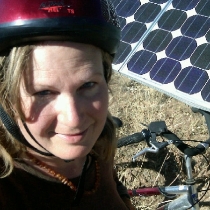Just three roundtrip cross-country or trans-Atlantic flights cause almost as much climate pollution as the average American household produces in an entire year. With that in mind, lots of fliers are concerned about the heavy carbon impact of their travel, and want to choose airlines that are at least operating as efficiently as possible.
Eco-conscious travelers may want to take a look at a new a new report by The International Council on Clean Transportation (ICCT), which ranks the efficiency of domestic operations by America’s major largest carriers.

The ranking shows that Alaska Airlines is the industry’s green North Star, using fuel 23 percent more efficiently than American Airlines, which is stuck near the bottom. Here are the full rankings:
This is a great tool for frequent as well as occasional fliers concerned about their ecological footprint. It should also be a red flag for airline investors. The airlines’ single biggest cost is jet fuel – more than salaries, more than health care, and definitely more than plane food – so a failure to use fuel efficiently usually means that the airline isn’t operating as profitably as it should be.
But it also shows that there’s a lot of room for improvement in the industry: for the most part, the laggard airlines have the potential to improve their performance by taking simple steps to boost the fuel efficiency of their planes with simple steps like installing winglets, towing jets on the ground, and flying at more efficient speeds.
The analysis is based on fuel consumption data reported by the airlines to the U.S. Bureau of Transportation Statistics using a new methodology that evaluates fuel efficiency relative to two factors – access and mobility. Previous attempts to measure efficiency amongst airlines have varied in outcomes based on differences in methodologies, metrics and overall findings.
The ICCT report compares the efficiency of all airlines independent of size, network structure, or type of service – which paints a clearer and more accurate picture than previous efficiency studies.
While this study is a great tool for eco-minded travelers, it also important to note that efficiency is only one piece of the puzzle in terms of assessing an airline’s environmental performance, and probably not the most important. A recent study from Manchester Metropolitan University indicates that a mandatory global cap on airline pollution is the quickest and most effective tool for reducing emissions – far trumping individual airlines’ voluntary efficiency moves.
That’s why we view the airlines’ political attitude as so important – and why United remains at the bottom of the pack in terms of its long-term impact on the climate. United has led the charge in lobbying against action to cap pollution, both at the international level through the International Civil Aviation Authority (ICAO), in Europe, and through the Clean Air Act. They’ve also filed lawsuits to block action. Now, United is urging governments to kick the can down the road yet again, urging them not to even decide on a global cap until 2016 – and even then take no action to actually reduce pollution.
Ironically, United-Continental would actually be well-positioned to profit from a cap on pollution: as a relatively efficiently operating airline, it’s likely that they won’t hit their pollution cap, and can actually sell their excess pollution permits to other emitters. Unfortunately, a knee-jerk adherence to the aviation industry’s historical kick-the-can-down-the-road attitude is getting in the way of both the planet and their own financial best interest.
Let’s hope this new study wakes them – and their investors – up to the need for a significant policy change.
This article was co-authored by Flying Clean Campaign Director Shelby White.



